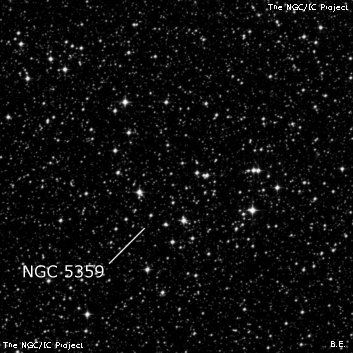NGC/IC Project Restoration Effort
(This is a very very beta version)
NGC5359


Basic Information
Location and Magnitude
Right Ascension: 13:59:48.0
Declination: -70:24:0
Constellation: CIR
Visual Magnitude:
Historic Information
Discoverer: Herschel J.
Year of discovery: 1835
Discovery aperture: 18.3
Observational
Summary description: Cl, vL, lRi, lC, st 11
Sub-type: OCL
Corwin's Notes
=====
NGC 5359. Found by JH, this may be nothing more than a random scattering of
Milky Way stars. However, it does look like a large scattered cluster, just
as JH has it. He picked it up twice. The first time (17 May 1835), he noted
it as a "Cl VIII class; vL, loose, straggling, stars L and S; fills field.
The star taken is a double one." The second time was just a month later on
18 June 1835; this time he called it a "Cl VIII class; irreg fig, 8' diam;
consists of about a dozen stars 11 m, and a great many 12, 13, 14 m."
I see two groups of stars here, one somewhat richer and larger to the
southwest (taken by Andris Lauberts in ESO-B as the cluster), and a second
smaller and poorer to the northeast. JH's first observation seems to
encompass both groups, though his position is for a double star on the western
edge. His second observation is more appropriate for the southwestern group.
So what should we take as the NGC object? The position that JH lists in the
GC, and that Dreyer carried on unchanged into the NGC, is a mean value of JH's
two observations. It doesn't help us much as it doesn't represent very well
what's on the sky. I have a slight preference for the southwestern group:
this is the most noticeable and JH's two positions fall within it, so it is
the one that I'm going to take.
However, I've listed positions and approximate diameters for all these groups
of stars, and I won't be annoyed if your choice is different from mine.
Steve's Notes
=====
NGC 5359
18" (7/11/05 - Magellan Observatory, Australia): at 76x I immediately noticed a 15' irregular chain of two dozen stars, roughly forming the outline of an animal - approximating a dog or horse. Within the position of the "head" of this figure is a pair of equal mag 10.5 stars at 11" separation. In fact, many of the brighter stars are 10th-11th magnitude. This chain is well detached in the field so it stands out well, although there are no dense spots and this loose group appears to be an asterism. Upping the magnification to 228x, at least 80 stars are visible within a 15' region. Listed as nonexistent in the RNGC.



